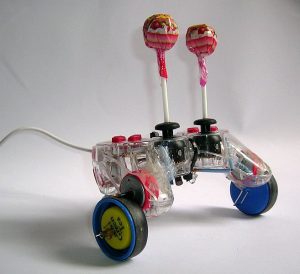
And the future of robotics education in Africa is … Chupa Chups?
When the African Robotics Network announced their $10 robot design challenge this summer, co-founder Ken Goldberg was careful not to share too many expectations, lest he influence contestants’ designs. But he never imagined one of the winning entries would prominently feature a pair of Spanish lollipops.
The challenge, hosted by AFRON co-founders Goldberg and Ayorkor Korsah, emphasized inexpensive designs to help bring robotics education to African classrooms. Goldberg announced AFRON’s 10 winners in three categories today at Maker Faire, including the lollipop-laden Suckerbot and traditional (roaming) category first prize winner Kilobot, a Harvard-spawned three-legged, vibrating, swarming robot.
“The ingenuity that has come from all over the world to address this problem is just astounding,” Goldberg said in an interview with Wired Design. “And we’re very excited about the next step, which is that once they’re awarded, some of them will become available products.”
The contest had a few simple restrictions, including the loose $10 target; entrants from around the world had to build a prototype, offer instructions on a website, and make the whole plan open-source, software included. The winners were little, an inch or two in size and up, never more than a foot long. They were sourced from cardboard, old cell phones, and circuit boards. They performed simple tasks: navigating, following lines, even communicating with each other.
“It’s a mix of people who really … want to make this happen,” said Goldberg. “No one here did this just to say ‘here’s something, a thought experiment’.”
Designs were judged by a 6-member jury of robotics industry professionals, and compiled by Goldberg and Korsah, who are professors at the University of California in Berkeley and Ashesi University College in Ghana, respectively.
Suckerbot, designed by Thomas Tilley, a computer scientist living in Thailand, started with a hacked PlayStation controller, and wound up winning first prize in the tethered robot category. In this case, the tether is the controller’s USB cable, and Tilley attached the rumble motors to a pair of wheels. Suckerbot’s list of parts comes to $8.96, but the real genius is the Chupa Chups. Tilley needed a way for the robot to sense if it ran into something, so he stuck a lollipop in each joystick. Whenever the Suckerbot bumps something, the weight of the sucker tips the joystick forward, and a signal is sent to the processor.
Many of the robots were created specifically for the challenge. Kilobot, however, was years in the making. Created by a Harvard robotics team, including Michael Rubenstein, Radhika Nagpal, and Christian Ahler, it was meant to be a multi-unit swarming robot. Having to build 1024 pieces made the project well suited for the event.
“If you’re going to build a lot of robots, you need to have them be cheap and easy to make and easy to use,” said Rubenstein. “So all of those things also aided in the AFRON challenge.”
“I think there is a great need for äóî not only in Africa, but even in the U.S. äóî low-cost robots that you could use for education,” Rubenstein went on. “There are people who try to make that now, but they’re only in the hundreds of dollars for an educational robot.”
The original article is from http://www.wired.com/design/2012/09/afron-winners/?utm_source=googleplus&utm_medium=socialmedia&utm_campaign=googleplusclickthru
